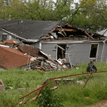Why Is Mesothelioma Increasing?

There has been a significant increase in death rates from mesothelioma in the past decade. The increase in mesothelioma cases has been attributed to the lack of a complete ban on asbestos in the U.S., significant natural disasters that destroyed buildings containing asbestos materials, and the Sept. 11 terror attacks that exposed rescue workers to the cancer-causing material, among other factors.
How Many Cases of Mesothelioma Are Diagnosed Each Year?
 Because the life expectancy for mesothelioma patients is generally one to two years, the number of cases diagnosed each year can be measured relative to the death rate. From 2005 to 2015, researchers saw a 7.8 percent increase in death rates from mesothelioma, according to the latest Global Burden of Disease Study (GBD 2015) published Oct. 8, 2016, in The Lancet. The study notes that the number of deaths worldwide from mesothelioma in 2015 was 33,400.
Because the life expectancy for mesothelioma patients is generally one to two years, the number of cases diagnosed each year can be measured relative to the death rate. From 2005 to 2015, researchers saw a 7.8 percent increase in death rates from mesothelioma, according to the latest Global Burden of Disease Study (GBD 2015) published Oct. 8, 2016, in The Lancet. The study notes that the number of deaths worldwide from mesothelioma in 2015 was 33,400.

In another study focusing on the U.S. alone, an estimated 15,000 Americans die every year from asbestos-related diseases, with mesothelioma accounting for nearly 3,000 deaths per year. The Environmental Working Group (EWG) indicates that during the period from 1999 to 2013, an estimated 127,579 to 159,480 Americans died from asbestos exposure.
What Is Causing the Rise in Mesothelioma in the U.S.?
There are several factors that may be contributing to the increase in mesothelioma cases in the United States:
 Asbestos use has not been banned completely in the U.S., and asbestos-containing materials remain in place in older homes, businesses, and schools. “Approximately 1.3 million workers in construction and general industry potentially are being exposed to asbestos during maintenance activities or remediation of buildings containing asbestos,” according to a report from the Centers for Disease Control and Prevention and the National Institute for Occupational Safety and Health. Construction photo
Asbestos use has not been banned completely in the U.S., and asbestos-containing materials remain in place in older homes, businesses, and schools. “Approximately 1.3 million workers in construction and general industry potentially are being exposed to asbestos during maintenance activities or remediation of buildings containing asbestos,” according to a report from the Centers for Disease Control and Prevention and the National Institute for Occupational Safety and Health. Construction photo Devastating storms, including Hurricane Katrina in 2005 and Hurricane Sandy in 2012, led to the destruction of buildings with asbestos-containing materials, increasing the risk of asbestos exposure. Future storms will have the same effect. Hurricane damage photo
Devastating storms, including Hurricane Katrina in 2005 and Hurricane Sandy in 2012, led to the destruction of buildings with asbestos-containing materials, increasing the risk of asbestos exposure. Future storms will have the same effect. Hurricane damage photo The 9/11 terrorist attacks exposed an estimated 41,000 people to asbestos and other toxins during the rescue and clean-up efforts after the Twin Towers collapsed, according to the CDC. 9/11 rescue worker photo
The 9/11 terrorist attacks exposed an estimated 41,000 people to asbestos and other toxins during the rescue and clean-up efforts after the Twin Towers collapsed, according to the CDC. 9/11 rescue worker photo Mineral mines in some states such as Montana and Minnesota may have contributed to higher than expected rates of mesothelioma. Miner photo
Mineral mines in some states such as Montana and Minnesota may have contributed to higher than expected rates of mesothelioma. Miner photo
Mesothelioma can develop 15 to 60 years after asbestos exposure occurs. That means any time there is an issue, such as a hurricane, for example, the potential for the rising number of mesothelioma cases extends for many more decades. Preventing asbestos exposure is the only sure way to halt increased rates of mesothelioma.
Which States Have the Most Mesothelioma Cases?
The number of mesothelioma cases is higher in the most populous states. California, Florida, Pennsylvania, New York, and Texas had the most asbestos-related deaths over the 14-year period covered in the EWG study. However, Delaware, Maine, Montana, Pennsylvania, Washington, and West Virginia had death rates that were 50 percent to 100 percent higher than the national average of 4.9 per 100,000 people.
I think we should separate into two charts here for comparison:
| State | NUMBER OF MESOTHELIOMA DEATHS (1999-2013) |
| California | 3,997 |
| Florida | 2,619 |
| Pennsylvania | 2,601 |
| New York | 2,253 |
| Texas | 2,064 |
| State | ASBESTOS-RELATED DEATH RATES (1999-2013)* |
| Maine | 10.1 |
| West Virginia | 9 |
| Montana | 7.9 |
| Delaware | 7.6 |
| Pennsylvania | 7.5 |
| Washington | 7.5 |
*Deaths per 100,000 people
What Does the Future Hold for Mesothelioma Cases in the U.S.?
“Ensuring a future decrease in mesothelioma mortality requires meticulous control of exposures to asbestos and other materials that might cause mesothelioma.”
Centers for Disease Control and Prevention, “Malignant Mesothelioma Mortality – United States, 1999-2005“
Free Mesothelioma Patient & Treatment Guide
We’d like to offer you our in-depth guide, “A Patient’s Guide to Mesothelioma,” absolutely free of charge.
It contains a wealth of information and resources to help you better understand the condition, choose (and afford) appropriate treatment, and exercise your legal right to compensation.
Download Now Asbestos use has not been banned completely in the U.S., and asbestos-containing materials remain in place in older homes, businesses, and schools. “Approximately 1.3 million workers in construction and general industry potentially are being
Asbestos use has not been banned completely in the U.S., and asbestos-containing materials remain in place in older homes, businesses, and schools. “Approximately 1.3 million workers in construction and general industry potentially are being  Devastating storms, including Hurricane Katrina in 2005 and Hurricane Sandy in 2012, led to the destruction of buildings with asbestos-containing materials, increasing the risk of asbestos exposure. Future storms will have the same effect. Hurricane damage photo
Devastating storms, including Hurricane Katrina in 2005 and Hurricane Sandy in 2012, led to the destruction of buildings with asbestos-containing materials, increasing the risk of asbestos exposure. Future storms will have the same effect. Hurricane damage photo The 9/11 terrorist attacks exposed an estimated 41,000 people to asbestos and other toxins during the rescue and clean-up efforts after the Twin Towers collapsed, according to the CDC. 9/11 rescue worker photo
The 9/11 terrorist attacks exposed an estimated 41,000 people to asbestos and other toxins during the rescue and clean-up efforts after the Twin Towers collapsed, according to the CDC. 9/11 rescue worker photo Mineral mines in some states such as Montana and Minnesota may have contributed to higher than expected rates of mesothelioma. Miner photo
Mineral mines in some states such as Montana and Minnesota may have contributed to higher than expected rates of mesothelioma. Miner photo